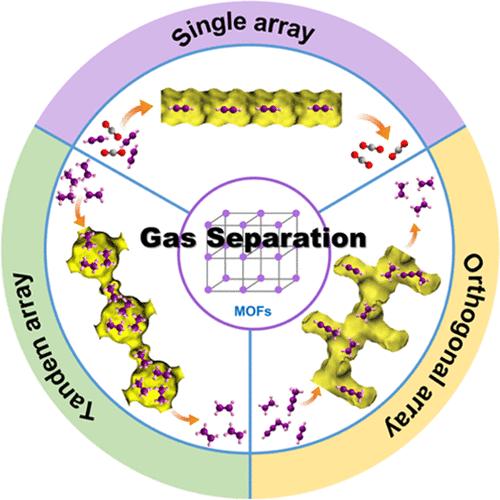Pore Engineering in Metal–Organic Frameworks for Enhanced Hydrocarbon Adsorption and Separation
IF 14
Q1 CHEMISTRY, MULTIDISCIPLINARY
引用次数: 0
Abstract
The separation and purification of hydrocarbons are crucially important processes in the petrochemical industry, as they are essential for producing high-quality chemicals and fuels. However, traditional thermal-driven separation practices, such as cryogenic distillation, are notoriously energy-intensive, accounting for a notable portion of the energy consumption in industrial operations. This has spurred the exploration and development of low-energy and sustainable alternative separation technologies, among which adsorption/desorption-based separation with porous materials has gained significant attention. Metal–organic frameworks (MOFs) are emerging as ideal porous materials for hydrocarbon separation due to their exceptional porosity and structural tunability. This Account delves into the latest advancements in microporous MOFs for hydrocarbon separation, categorizing them based on their pore structures: single array, tandem array, and orthogonal array. Single-array MOFs feature uniformly arranged channel-like pores along the axial direction, facilitating the incorporation of binding sites on the pore surfaces. One notable functional group used in these applications is open metal sites (OMSs), which can engage in strong metal-π interactions with unsaturated hydrocarbons such as acetylene. For example, JNU-1 demonstrates increased binding energy with the increasing pressure of acetylene due to the induce-fit effect, where framework contraction behavior is triggered by its OMSs. JNU-4 offers two binding sites per metal center for acetylene molecules, greatly improving the adsorption capacity. On the other hand, introducing low-polarity groups, as seen in JNU-6-CH3, can effectively enhance the separation performance in favor of alkanes while maintaining structural integrity under humid conditions. Another methyl group-modified MOF, JNU-5-CH3, exhibits an acetylene-triggered gate-opening effect due to the multiple supramolecular interactions with acetylene. Tandem-array MOFs provide enhanced selectivity and adsorption capacity through the interconnection of spacious cavities with narrow apertures. For instance, JNU-2 with pore-channel interconnected structure exhibits improved separation efficiency for C2H6/C2H4 and hexane isomers. The slim channels connecting the large cavities act as screening sites for matching-sized molecules to pass through, while the large cavities function as storage sites for large adsorption capacity. Orthogonal-array MOFs, like JNU-3a, feature one-dimensional (1D) channels that enable rapid diffusion, complemented by molecular pockets on both sides that facilitate selective recognition. The dynamic “gourd-shaped” opening of the pocket demonstrates notable adaptability when interacting with different hydrocarbons, allowing for sieving-like behavior in the separation of propylene/propane, as well as efficient separation of ethylene from its mixtures with alkynes of various sizes. Overall, the designability and tunability of MOF pore structures make them promising candidates for effectively discriminating targeted molecules from multicomponent mixtures, offering energy-efficient solutions for challenging industrial separations.

金属-有机骨架的孔隙工程增强碳氢化合物的吸附和分离
碳氢化合物的分离和纯化是石化工业中至关重要的过程,因为它们对于生产高质量的化学品和燃料至关重要。然而,传统的热驱动分离方法,如低温蒸馏,是出了名的能源密集型,在工业操作中占能源消耗的很大一部分。这刺激了低能耗和可持续的替代分离技术的探索和发展,其中基于吸附/解吸的多孔材料分离得到了极大的关注。金属有机骨架(mof)由于其优异的孔隙度和结构可调性而成为分离碳氢化合物的理想多孔材料。本文深入研究了用于碳氢化合物分离的微孔mof的最新进展,并根据其孔结构对其进行了分类:单阵列、串联阵列和正交阵列。单阵列mof具有沿轴向均匀排列的沟道状孔,有利于结合位点在孔表面的结合。在这些应用中使用的一个值得注意的官能团是开放金属位点(OMSs),它可以与不饱和碳氢化合物(如乙炔)进行强金属-π相互作用。例如,由于诱导拟合效应,JNU-1的结合能随着乙炔压力的增加而增加,其中框架收缩行为是由其oms触发的。JNU-4在每个金属中心为乙炔分子提供两个结合位点,大大提高了吸附能力。另一方面,引入低极性基团,如在JNU-6-CH3中所见,可以有效地提高有利于烷烃的分离性能,同时在潮湿条件下保持结构完整性。另一种甲基修饰的MOF JNU-5-CH3由于与乙炔的多重超分子相互作用而表现出乙炔触发的门打开效应。串联阵列mof通过宽孔窄孔的互连提供了更高的选择性和吸附能力。例如,具有孔道互联结构的JNU-2对C2H6/C2H4和己烷异构体的分离效率更高。连接大空腔的细通道充当匹配大小分子通过的筛选位点,而大空腔则充当大吸附容量的存储位点。像JNU-3a这样的正交阵列mof具有一维(1D)通道,可以实现快速扩散,两侧的分子口袋可以促进选择性识别。当与不同的碳氢化合物相互作用时,口袋的动态“葫芦形”开口表现出显著的适应性,允许在分离丙烯/丙烷时具有类似筛网的行为,以及有效地将乙烯从其与各种大小的炔的混合物中分离出来。总的来说,MOF孔隙结构的可设计性和可调节性使其成为有效区分多组分混合物中目标分子的有希望的候选者,为具有挑战性的工业分离提供了节能解决方案。
本文章由计算机程序翻译,如有差异,请以英文原文为准。
求助全文
约1分钟内获得全文
求助全文

 求助内容:
求助内容: 应助结果提醒方式:
应助结果提醒方式:


